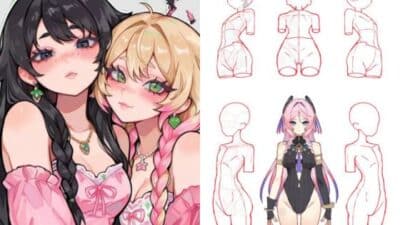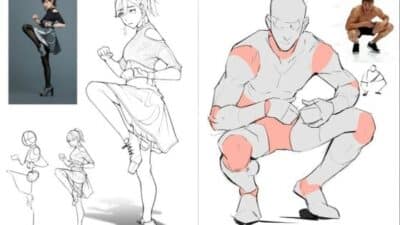How to Draw Bodies That Look Right (Even if Youre a Beginner)
Drawing the human body is one of the most rewarding challenges an artist can tackle. It’s a journey of translating the complex, dynamic beauty of the human form onto a flat surface. But let’s be honest: when you’re starting out, that journey can feel more like a frustrating trek. Your figures might look stiff, their limbs might seem out of whack, and the whole thing just feels… off. It’s a common hurdle, but it’s one you can absolutely clear. The growing passion for creative outlets is clear, with the global arts and crafts market valued at around $45.28 billion in 2024, showing just how many people are picking up a pencil and diving in. This guide is your friendly roadmap to get you past the initial struggle and on your way to drawing bodies with confidence.


The Beginner’s Struggle: Why Do My Drawings Look… Off?

If you’ve ever drawn a person with a head that’s too big, arms that are too long, or a pose that looks more like a pretzel than a person, you’re not alone. The Human Body is incredibly complex. It has a rigid skeleton, a flexible muscular system, and it can bend, twist, and balance in countless ways. Trying to capture all of that at once is overwhelming. Most beginners make the mistake of focusing on the details (the eyes, the fingers) before they’ve built a solid foundation. This results in drawings that lack structure, proportion, and a sense of life.
Good News: You Don’t Need to Be a Master (Yet!)
Here’s the secret: you don’t need to memorize a medical textbook on human anatomy to draw a believable person. You don’t need to know the name of every single muscle or bone. What you need is to understand the basic shapes, proportions, and mechanics that make the body work. It’s about learning to see the human form not as a complicated mess of details, but as a collection of simple, interconnected parts. This guide will break it down into manageable steps that anyone can follow.
What We’ll Cover: Your Roadmap to Better Body Drawing


We’re going to build your skills from the ground up. First, we’ll loosen up and capture energy with gesture. Then, we’ll construct the body using simple shapes and learn the fundamental rules of proportion. After that, we’ll add volume to make your figures feel three-dimensional. Finally, we’ll put it all together to create dynamic and interesting drawing poses. Ready? Let’s get started.
Loosen Up! The Magic of Gesture Drawing


Before we even think about muscles or skeletons, we need to talk about feeling. The first step to drawing a body that looks right is to capture its energy and movement. This is where gesture drawing comes in, and it’s a total game-changer.
What Exactly is Gesture Drawing? Capturing the Vibe!
Gesture drawing is the art of quick, expressive sketching. The goal isn’t to create a perfect, detailed outline but to capture the “gesture” or essential action of a pose in just a few seconds. Think of it as the drawing equivalent of a first impression. You’re not focused on what the person looks like, but on what they are doing. It’s about capturing the flow, the weight, and the rhythm of the human form.
Why It’s Your Secret Weapon: Energy, Movement, and the Human Form
Starting with a gesture drawing infuses your work with life from the very beginning. A figure built on a stiff, lifeless outline will always feel static. But a figure built on a dynamic, flowing gesture line will retain that energy, even after you add details. It forces you to see the body as a whole, interconnected unit rather than a checklist of body parts. This practice is fundamental to successful figure drawing.
How to Do It: Quick Lines, Big Impact (No Perfection Allowed!)


Grab a pencil or your Apple Pencil and set a timer for 30 seconds. Find a reference photo and, in that short time, try to capture the entire pose with one or two flowing lines. The most important line often follows the spinal column, from the head down through the torso. Don’t lift your pencil if you can help it. Scribble! Be messy! The only rule is: no erasing and no getting caught up in details.
Practice Time: Looking at Reference Images for Movement, Not Detail
The best way to get good at gesture drawing is to do it a lot. Use online resources with timed poses or just pause a movie and sketch the actors. When you look at your reference images, train your eye to ignore the face, the clothes, and the hair. Instead, look for the main line of action. Is the spine curved or straight? Which way are the hips tilting? Where is the weight resting? These are the questions that will lead you to a powerful gesture.
Building Blocks: Understanding the Body’s Simple Structure


Once you’re comfortable capturing energy, it’s time to give that energy some structure. This is where we break the body down into simple, manageable shapes. Thinking this way removes the intimidation factor and gives you a solid blueprint to build upon.
Think Shapes, Not Super-Complex Anatomy


Look at the Human Body. What do you see? Instead of a person, try to see a collection of simple 3D forms. The head is an oval or sphere. The neck, arms, and legs are cylinders. The hands and feet can be simplified into wedge or box shapes. The torso is the most complex part, but we can break that down too. This approach is the foundation of all figure drawing.
The Torso: Your Body’s Central Hub


The torso is the anchor for the rest of the body. We can simplify it into two main masses. The upper part is the rib cage, which you can think of as an egg or barrel shape. It’s fairly rigid and holds the vital organs. It’s connected via the flexible spinal column to the lower part of the torso. This spine, with its distinct curves—the cervical spine (neck), thoracic spine (upper back), and lumbar spine (lower back)—is what allows for all that wonderful twisting and bending.
The Pelvis: The Foundation for Legs
The second key mass of the torso is the pelvis. You can draw this as a flattened bowl, a box, or even a shape that looks a bit like a pair of shorts. The rib cage and pelvis can tilt and twist independently thanks to the flexible lumbar spine connecting them, which is key for creating dynamic poses. The pelvis is the solid base from which the legs connect.
Limbs Away! Arms and Legs Made Easy (Connecting to the Torso)

With the torso established, adding limbs is straightforward. Think of them as a series of connected cylinders. The upper arm connects to the shoulder area of the rib cage, and the upper leg connects to the side of the pelvis. Use simple circles or spheres to represent the joints (shoulders, elbows, knees), as this will help you visualize how they bend and move.
Your First “Body Chart”: Drawing Simplified Human Dummies


Combine these simple shapes, and you have your very own body chart or mannequin. These simplified human dummies are fantastic tools. You can draw them in any pose you can imagine, focusing purely on the core structure and proportion before worrying about details like muscles or clothing. This is your blueprint for a solid, believable figure.
Getting the Proportions Right: Making Sense of Size


You’ve captured the gesture and built a simple structure. Now, let’s make sure everything is the right size. Proportions are the relationships between the sizes of different body parts. Getting them right is what makes a figure look believable instead of distorted.
Why Proportions Matter (No More Giant Hands or Tiny Heads!)


Proportions are the silent framework that holds your drawing together. When they’re off, the viewer immediately senses that something is wrong, even if they can’t pinpoint exactly what. Correct proportions ensure that the head isn’t too large for the body, the legs aren’t comically short, and the hands can’t palm a basketball if the character is five feet tall.
The “Eight-Head Rule” (Simplified for Beginners – It’s a Guide, Not a Law!)


A classic guideline used by artists for centuries is the Eight-Head Rule. This system uses the height of the head as a unit of measurement for the rest of the body. In an “ideal” heroic figure, the body is roughly eight heads tall.
- Head 1: The head itself.
- Head 2: Ends at the nipples.
- Head 3: Ends at the navel.
- Head 4: Ends at the crotch/pelvis.
- Heads 5-8: Make up the legs.
This is a fantastic starting point, but remember, it’s a guide, not a strict law. Real people come in every body shape and size!
Visual Checks: Your Eyes Are Your Best Tool (Measuring Against Reference Images)


The best way to master proportion is to observe. When working from reference images, constantly compare parts of the body to each other. How many heads wide are the shoulders? Does the elbow line up with the navel? Is the hand as big as the face? Use your pencil or Apple Pencil as a measuring tool by holding it up to your screen or reference to compare lengths and angles.
A Nod to the Vitruvian Man: How Artists Have Explored Proportions for Ages
Artists have been obsessed with perfecting human proportions for millennia. Leonardo da Vinci’s famous Vitruvian Man is a perfect example, showing how the ideal human body fits within a circle and a square, symbolizing symmetry and balance. It’s a powerful reminder that understanding proportion is a timeless artistic pursuit.
From Skeletons to Smooth Forms: Adding Volume and Curves


Your drawing now has energy, structure, and correct proportions. The next step is to transform that wireframe skeleton into a figure with weight and dimension. It’s time to add flesh to the bones.
Thinking in 3D: Giving Your Shapes Depth
Remember those simple cylinders and boxes we used? Now, think of them as solid 3D forms. A cylinder has a top, a bottom, and a curved surface. A box has multiple planes. Start drawing through your shapes, sketching the unseen back-side of a cylinder or box. This simple trick forces your brain to think in three dimensions and helps you place forms correctly in space. Using a graphic tablet can be great for this, as you can put these construction lines on a separate layer and easily hide them later.
A Peek at Muscles: Where the Curves Come From


You don’t need to be a doctor, but a basic understanding of the muscular system helps immensely. Muscles are what create the bumps, curves, and contours of the body. Look at a simplified anatomy chart—not a dense medical infographic, but one made for artists. See how the deltoid muscle wraps around the shoulder, or how the calf muscles create a distinct curve in the lower leg. You’re not memorizing them; you’re just observing the shapes they create on the surface.
The Magic of Overlap: Creating a Sense of Space in Your Human Silhouette
One of the easiest ways to create depth is through overlapping lines. When one arm is in front of the torso, its outline will cross over and cover part of the torso’s outline. This simple act tells the viewer’s brain which object is closer. Pay attention to this as you refine your human silhouette. Overlap defines the form and pushes your figure from a flat shape into a three-dimensional being.
Let’s Get Posing! Bringing Your Bodies to Life


With all the foundational pieces in place, it’s time for the most exciting part: creating dynamic and expressive drawing poses. This is where your understanding of gesture, structure, and form all come together.

Starting with a Simple Stick Figure (Your Gesture Drawing’s Next Step)
Every great pose begins with a simple skeleton. Start with your gesture line to capture the energy. Then, build a simple stick figure over it, indicating the head, the line of the spine, the shoulders, the pelvis, and the limbs. This basic stick figure acts as the armature for your pose, establishing the angles of the joints and the distribution of weight.
Building on Your Blueprint: Adding Forms and Volume
Once your stick figure looks right, start wrapping it with the simple 3D shapes we practiced earlier: the egg-shaped rib cage, the bowl-like pelvis, and the cylindrical limbs. This process ensures your final figure is not only well-posed but also structurally sound. As you draw, consider how parts of the body might rotate on a transverse plane (horizontally), like when a character twists their torso to look behind them.
Common Drawing Poses to Practice


The best way to improve is by drawing a variety of poses. Start with the basics:
- Standing: Experiment with different weight distributions.
- Walking/Running: Capture the natural counterbalance of arms and legs.
- Sitting: Observe how the torso and legs fold and compress.
- Reaching/Stretching: These poses are great for showing the flexibility of the
spinal column.
Participating in a community challenge can be a fantastic motivator, often providing a list of themed poses to try each day.
Conclusion
Drawing the human body doesn’t have to be a source of frustration. By breaking it down into a clear, step-by-step process, you can turn a daunting task into an achievable and deeply satisfying skill. Remember the core roadmap: start with the energy of gesture drawing, build a solid foundation with simple shapes, check your proportions with guides like the Eight-Head Rule, add believable volume by thinking in 3D, and bring it all to life with dynamic posing.
Your next steps are simple: practice. Don’t aim for a masterpiece every time. Instead, fill pages with quick gestures and simple mannequin figures. Use reference images constantly to train your eye. Whether you’re using traditional tools like the versatile Arteza Professional Pencil Drawing Set to explore different lead hardness for sketching and shading, or embracing the flexibility of digital drawing with a graphic tablet, the principles remain the same. The key is to stop seeing a complex person and start seeing the simple, beautiful mechanics underneath. So grab your tools, find some inspiration, and start drawing. You’ve got this.
- 3.1Kshares
- Facebook0
- Pinterest3.1K
- Twitter0



